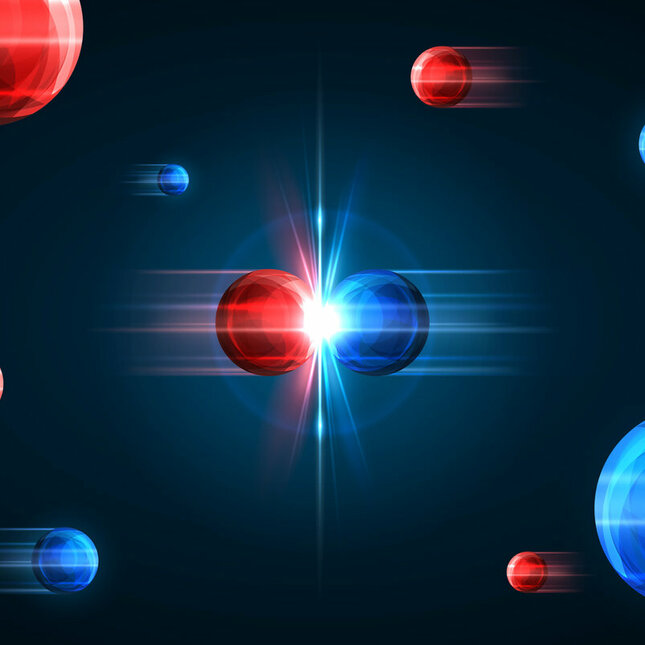Superfluids and Higgs are a match made with ultracold atoms
In a worldwide collaboration, current and former TU/e researchers have studied oscillations in ultracold atomic clouds and shown similarities with oscillations of the Higgs boson.
![[Translate to English:] [Translate to English:]](https://assets.w3.tue.nl/w/fileadmin/_processed_/1/9/csm_Kokkelmans%20Banner%20image_ea407c52c5.jpg)
Experimental researchers from Australia, together with theoretical researchers from Eindhoven, France, Italy and the United States, have taken an ultracold and strongly interacting superfluid and explored what happens when the strength of the interactions between the particles in the fluid is rapidly increased by varying a magnetic field. The new work is published in the journal Physics Review Letters.
Superfluids might sound like something fictional from a superhero film, but Servaas Kokkelmans, full Professor at the Department of Applied Physics and Science Education, knows otherwise.
“Yes, superfluids do exist, and the physics behind them is fascinating,” says Kokkelmans who is also the scientific director of the Center for Quantum Materials and Technology Eindhoven (QT/e).
In terms of state of matter, a superfluid is a fluid with a twist – it has zero viscosity. This means that it can flow without losing any of its kinetic energy. “As you can imagine, a fluid that moves without losing any energy would be very useful research and in industry,” Kokkelmans adds.

Superfluid flavors
Superfluids come in two main flavors or condensates – Bose-Einstein and fermion. The Bose-Einstein condensate is named after Satyendra Nath Bose and Albert Einstein, who both contributed to its prediction at the start of the 20th century. A prominent example is the superfluid helium-4, a stable isotope of helium which reaches a zero-viscosity state at a rather chilly -270.98 degrees Celsius.
On the other hand, a fermion condensate or Fermi gas is more elaborate and is made of pairs of particles that are bound together by their attractive interactions. Examples of fermions include quarks, which make up protons and neutrons, and leptons – such as electrons or muons. In fact, it’s the fermion condensate phenomenon that forms the basis of superconductivity – the process by which specific materials lose their electrical resistance when cooled to low enough temperatures.
For Kokkelmans it’s the latter that is of major interest. “Superfluid fermi gases depend greatly on the strength of their interactions, and these interactions are affected by magnetic fields.”
So, Kokkelmans along with a group of researchers scattered across the world took an ultracold atom ‘cloud’ and explored the response of the constituents in the ‘cloud’ when the strength of the interactions is increased using magnetic fields.

Enter the Higgs field
“Changing the field brought pairs of atoms closer together. So, we observed how the vibrations of each pair combined to create an oscillation across that fermionic gas,” says Kokkelmans. “We found that the excited pairs broke up into free atoms and the superfluid then relaxed.”
The researchers used a mathematical model of the collective oscillations to reveal similarities with the so-called Higgs field.
“The Higgs field is predicted to exist across the universe, and associated with the field is the Higgs boson,” says Kokkelmans.
The Higgs field and the associated boson are responsible for the mass of the elementary particles. In simple terms, the Higgs field is what gives mass its mass. Earlier this year, Peter Higgs – the British theoretical physicist after whom the boson is named – passed away at the age of 94.
“This connection highlights a powerful analogy between emergent phenomenon in ultracold atomic systems and many other branches of physics despite radically different behavior at the microscopic level,” says Kokkelmans.

Long time coming
For Kokkelmans though, the simulations that form part of this study have their origin in a model for superfluidity that he worked on while a postdoctoral researcher at the Joint Institute for Laboratory Astrophysics (JILA), Colorado some 23 years ago.
“There I learned the techniques of quantum field theory, which I combined with the knowledge that I built up during my PhD on strongly interacting atoms. With this new model, we studied the crossover between the physics of a Bose-Einstein condensate and a superfluid Fermi gas, based on the actual interatomic pairing mechanism.”
Initially, Kokkelmans and his collaborators had a hard time getting that work published. It was rejected by two different journals based on very negative referee comments.
“Later on, the model became very popular in the quantum gases community, in particularly when we used it to explain experimental observations that could not have been explained otherwise. Now it is my second-highest cited paper!”
Old collaborations can last forever
Many years later, when Kokkelmans got his Vici grant from NWO, he formed a wonderful team of people to continue working on strongly interacting quantum gases, and three of them are co-authors of this new paper.
“These PhD students and postdocs have now all gone elsewhere - Italy and USA, France, Belgium - and they are still in academia or work for a quantum technology company, but we stayed in touch to tackle this problem,” says Kokkelmans. “I'm very proud to see how they all moved on and are now in different stages of their career, but also that in their heart they all remain very curious about discovering new fundaments of physics."
Full details on the paper
“Higgs oscilations in a unitary Fermi superfluid”, P. Dyke et al., Physics Review Letters, 132, 223402, (2024).
Media contact
Latest news
![[Translate to English:] [Translate to English:]](https://assets.w3.tue.nl/w/fileadmin/_processed_/6/2/csm_universiteit%20jos%20keurentjes%20energie%202_d469fe3b2f.jpg)
![[Translate to English:] [Translate to English:]](https://assets.w3.tue.nl/w/fileadmin/_processed_/2/2/csm_Pre-EditLeviBaruch-0003_558369f155.jpg)
![[Translate to English:] [Translate to English:]](https://assets.w3.tue.nl/w/fileadmin/_processed_/7/d/csm_Boutin%20Banner%20image_165e239d2b.jpg)